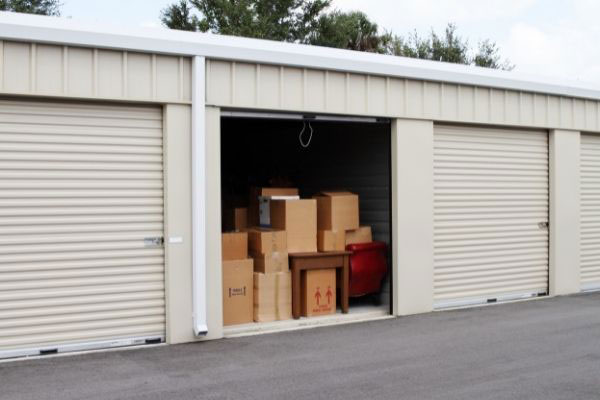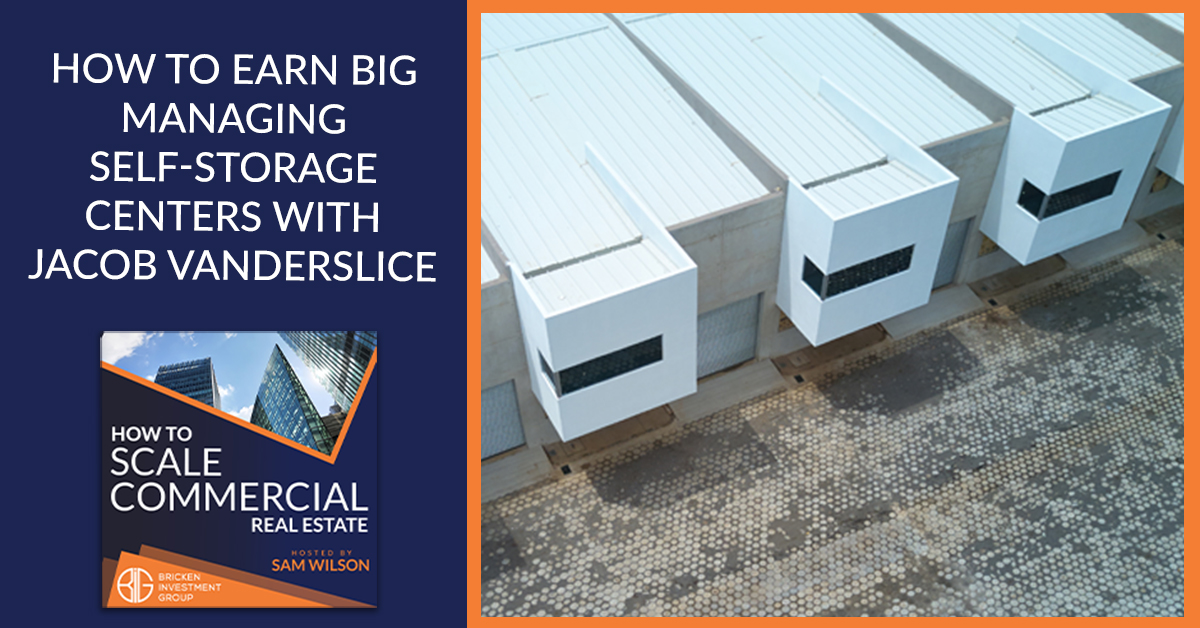How can you earn big managing self-storage centers? Buy existing facilities that are undermanaged and then add value. Sam Wilson’s guest in this episode is Jacob Vanderslice, the Principal at VanWest Partners. Jacob talks with Sam about taking time to make sure each transaction has a more long-term hold, with more cash flow and income. The greatest mistake you can make? Not taking action. So go out there and practice closing deals. But first, listen to this episode. You won’t regret it!
—
Watch the episode here:
Listen to the podcast here:
How To Earn Big Managing Self-Storage Centers With Jacob Vanderslice
Our guest is Jacob Vanderslice. He’s a principal at VanWest Partners. They are a Denver-based real estate investment firm. They focus on the acquisition, management of self-storage centers and other opportunities for real estate throughout the US. They have a track record with over $225 million in real estate assets. Jacob and his partners’ success are driven by a commitment to delivering an expertly executed adaptable strategy with an institutional investment approach. Welcome to the show, Jacob.
Good day, Sam. Thanks for having us on now. We appreciate it.
The same three questions I ask everyone who comes on the show. Can you quickly tell us where did you start, where are you now and how did you get there?
I’ll try and make it as concise as possible. I started off many years ago doing single-family fix and flips. We grew that platform quite a bit in the following years. We’ve done over 1,000 of them all over the country and then we got into commercial real estate. In ’13 and ’14, we were doing a lot of adaptive reuse, retail around Denver. We were repurposing old warehouses into multi-tenant experience-based retail concepts, breweries, restaurants and gyms.
We got into self-storage in 2015. We looked at the asset class for a number of years and we liked it because it’s been historically recession-resistant. It’s performed well during downturns. We built our first facility in Denver that we completed with a joint venture with some high-net-worth investors here in town. We completed that in 2017 and we still own that. We grew the platform from there. We expanded to the Midwest and to the Milwaukee market. Now we own 33 facilities in the Denver front range but mainly in the Midwest and Southeast. Self-storage has been our main strategy in the last couple of years for the foreseeable future.
What was it like when you guys transitioned? You said you guys had done everything, but as you finally niche down and said, “Self storage.” Was it difficult cutting off other lines of business?
We kept our other lines of business going on for a long time. We kept our single-family line of business going until about several years ago. That was more of a labor of love than anything else. We weren’t making a lot of money at it. It’s a given how tough deal flow is in Denver and how much institutional capital is in the space.
We added that to our platform because one of the main mistakes we’ve made in our real estate careers pretty consistently is being overly transactional and by that I mean, buying, making better and selling too often and quickly. We wanted a strategy that would be more of a long-term hold, more cashflow and income-focused versus being transaction-focused, buy, make better and sell. We thought self-storage is a good vehicle for that and that’s proven to be true, especially the last couple of years. It’s been a good asset class.
What do you mean by that when you say buy, make butter and sell? We see a lot of that in multifamily in a five-year business plan and things like that. Is that what you’re referring to?
One of the main mistakes you can make in real estate is being overly transactional.
There was a time and a place to sell. If you get a crazy price, it’s tough not to sell but the problem with being overly transactional is number one, you generate a lot of tax liability. You build up cash but you pay a lot of taxes. The second issue with it is you have a return a capital event. The deal sells and hopefully, you make good money, but then you’re sitting on cash. You have to take a new round of risk and redeploy that cash into a new vehicle. That takes a lot of work. We designed our storage funds to be more of a medium to longer-term cashflow play with capital appreciation and upside, but good above-market, durable recurring revenue streams.
The problem that a lot of sponsors run into with the long-term holds is that investors typically want their capital back in a shorter timeframe. They might say, “We want it back in five years.” Most investors aren’t okay with saying, “We’ll give it back in twenty years.” How do you guys overcome that hurdle?
Our underwritten hold periods are around seven years. It could be a little bit more or less, but that’s certainly a challenging hurdle. The way our fund is structured, everything above and beyond preferred return goes to return investor capital accounts before anything else happens. Over time, excess net cashflow is generated, their capital accounts are paid down incrementally every year. People are more concerned about when does my money comes out and over what time period. That return of capital event is not necessarily tied to a sale. There are a lot of mechanisms at play that can return investor capital that is a fee simple arm’s length sale on the open market.
I’ve not heard that strategy before where you have a preferred return, which is not a return of capital situation. Anything above the preferred, you guys are treating as a return of capital.
If we have an 8% preferred return, a $100,000 investor who gets $12,000 in distributions in a given year, $8,000 of as preferred return and $4,000 of that reduces the capital account from $100,000 to $96,000. It’s rinse and repeat.
That’s an interesting hybrid approach I’ve not heard of before. You said there are some other ways to do that besides a fee simple transaction. Are there other methods you guys are employing?
Another way to return capital and an obvious one is potential refinance years down the road. That’s replacing investor equity with bank debt. We’re not underwriting a refinance in our modeling. We likely won’t do one any time soon. Our debt’s very competitive, at least for self-storage, it’s not nearly as good as multifamily, but it’s still very attractive.
Another option for a liquidity event could be a recapitalization of the portfolio with a new source of equity. It gives folks the option to stay in the fund on a stepped-up basis and increase tax-free evaluation or have a liquidity event. The most obvious of all of them is a fee simple sale of the portfolio to either large private equity or institutional capital.
Break that down for me because I’m not sure I completely followed that event there. You Institute or you bring in new capital into the fund, but how does an investor retain their position in the fund if they get their capital back?

They would have the option too. There is another shop we’re familiar with. They’re a big multifamily developer out of the Midwest. They have a lot of developments in syndications and multifamily. They were single asset syndications with a fairly common capital base but every deal was a standalone entity. They rolled all of those properties up into an income fund once they were stabilized and they gave the limited partners in those syndications an option to either roll into the income fund at a stepped-up tax-free basis or cash out. Most folks decided to roll in and went along for the ride. That’s another option in terms of giving folks the option for liquidity without a third-party open market fee simple sale.
You guys are underwriting for a seven-year hold. One of the things that maybe we could talk about now is how you can use self-storage in retirement, are their intentions for getting at some point where you can hold it longer even than that?
If we could create a scenario where refinanced proceeds drove a substantial return of capital, if not a complete return of capital. I think the incentive to sell, if and when that happened, would be diminished because the investors in the fund and ourselves have largely been de-risked because our principals are back. Even though our money’s back, we’re still continuing to get distributions. We’re still getting the tax benefits of holding real estate. That could be a scenario where that whole period is extended.
Within our documents, we didn’t do a hard exit date. Let’s say we decided to sell everything in year five on our PPM. We didn’t do that because we didn’t want to be forced to sell into an environment that’s not ideal to sell into. Let’s say if year five comes and for whatever reason, maybe cap rates have gone up, but the value of the asset base may have declined but we’re still making great distributions and creating great cashflow. We don’t want to be selling into an environment that’s ideal to sell into.
When it comes to self-storage, you guys branched out. Was it a ground-up build that you said you did in 2017?
Yeah. We did a number of ground-up projects here in Denver. We repositioned the multi-story office building into self-storage. Our fund strategy has been purely focused on buying existing facilities that are under-managed and adding value through our operating platform. It’s bringing below market customers up to market rates, growing occupancy and controlling expenses. We are seeing a new opportunity to get back into development that we haven’t seen for a couple of years. We’ll likely be doing some single assets indication development deals, maybe starting in Q2 to Q3 of 2022. We haven’t built for a while but the deals we have, we still own.
We’ll take a little left turn here and talk about this office building to self-storage project you guys did. The common question right now is, will the office return? What does that look like going forward? Talk us through that project. That sounds fascinating.
One of the risks of self-storage is oversupply. When you have oversupply, rates and occupancy decline.
We have done two of them. One was a bit larger and one’s a bit smaller. The larger one was interesting because the structural loads were not adequate for self-storage. We had to install carbon fiber or papier-mache on the load-bearing beams to structurally reinforce it up to a floor load level that would support storage use. As you can imagine, that was expensive and took a while but it turned out to be a good project.
That deal is South of Downtown Denver. The other building we did, which was an industrial office is we bought a building also South of Downtown Denver. We converted the upstairs into nice office space, which is where I’m sitting right now and the ground floor to climate-controlled self-storage. We live and work in a storage facility.
It keeps you close to the market.
It’s our showroom. When somebody wants to know what storage looks like, they just come downstairs.
When you say that there are going to be new opportunities for ground-up, what has shifted that it is something you’re now thinking about again?
One of the risks and self-storage is oversupply. When you have oversupply, you have a decline in rates and occupancy. Your deals don’t perform like you thought they would, a lot of people built around the same time in 2019. In Denver and some other markets, the rates went down. Those rates have recovered. The entire industry is had a very record-setting year in terms of occupancy growth and revenue growth.
A couple of years ago, a multi-story new construction deal might’ve gotten $1.50 per square foot per month and now that same deal was probably at $1.80 or maybe even $2 a foot per month. As those rates have gone up, this inflationary environment and higher consumer demand environment, we’re seeing it make more sense to target difficult to entitle sites in high barrier to entry markets where it’s tough to get city approval.
It’s tough to execute on the construction side and once you build a product type like that, that’s difficult to replicate. We believe the buyer demand or something like that and stabilization will be pretty substantial because you can’t make more of them. Rents have gone up and stabilized. Supply has stabilized. We think now is the time in certain parts of the country to get back into it.

It seems like you guys have a tool in your tool belt to cut through all of that nonsense that everyone else doesn’t want to undertake. The reason that those facilities aren’t built yet and the reason they will be valuable because it’s such a pain in the neck to get them built.
It is and on many sites, you have to get a rezoning done, which is a lengthy, expensive and risky process. You have to have a lot of runway on your contract between when you signed the contract when you close. A lot of sellers don’t want to do that. They’re tough to find and they’re even tougher to execute, but that difficulty is what creates the value.
How do you guys identify those sites? What are some of the things early on that make you say, “Yes, we think we could do something with this or no?”
We look at a few things. We look at the current supply ratios and the submarket. Self-storage is very local supply sensitive in the one, three and five-mile trade radius. National supply ratios are certainly a data point, but they’re more sub-market level. We’ll look at that first and then we’ll analyze the amount of new supply against the forecasted population growth that would have to happen before supply becomes out of balance.
If we determine, a lot of deals have to get built over the next five years in this submarket to have an imbalance in supply, that’s probably an acquisition that we’ll go after. Beyond that, we’re underwriting the lease-up velocity, once you deliver the project, the hard costs, contingencies, site work, budgeting and third-party reports. Are there environmental issues and zoning analysis? There is a lot that go into it but mainly on the frontend. It’s exercise, supply now and where that supply is expected to go over the next 3 to 5 years?
One of the things, Jacob, that you mentioned was the lease-up of the facility. I think that’s a unique nuance in this, especially when building new. How do you forecast lease-up? Is that unique to each location or is it something that you can say, “We know on average, it takes this amount of time?”
You can have good discounts on a few portfolio acquisitions just by having relationships.
It’s pretty unique to each location. In general, if you build a new facility, it’s going to take you at least 18 months, maybe 2 years, to move your first customer. Once you move your first customer in, it’s probably an additional three years before you’re getting stabilized. When you’re delivering a vacant self-storage property that’s new, you price your rent very far below market to drive that occupancy up. You’re not giving away units, but you’re substantially discounting units. As you get to critical mass occupancy, you start tweaking your revenue management and increasing rates over time. Round trip on a development deal from land acquisition to stabilization, it’s probably going to take you five years.
Five years to where that thing becomes wildly profitable or five years until it turns a profit?
It’ll be turning a profit before than five years until stabilization. Let’s say you want to build these things to a 7% cap and sell them at a 5.5% cap. You will not probably achieve that 7% cap until three years of operations from delivery.
What constitutes stabilized? Is it 12 months or 24 months of consistent revenue?
I’d say it depends on where you’re at in the market cycle. Right now, the storage valuations, just like a lot of asset classes are using a very short amount of history. It’s prudent to use more history like the last 2021, but if you go back 12 months or 18 months, there are a lot of wonky data points that hopefully will not happen again. A lot of underwriting these days is annualizing T3 and then count on a look-forward basis. You might consider yourself stabilized after you’ve got that first three months of stabilized and operating income.
How are you guys finding opportunities nationwide because you’re doing more than working there in the Denver market?
We’re in the Midwest and Southeast. Over 70% of our deals are sourced off-market through broker relationships. Sometimes when you hear off-market, you think, “It’s not off-market. It’s a bad deal.” These are off-market and we believe we’re pretty good discounts on a few portfolio acquisitions by having relationships. The other third of our deals are marketed, but they’re often inefficiently marketed. Maybe it’s a residential broker who takes it to market or it’s a guy that’s not doing a good job providing financials to buyers.
We had a deal that we bought in Florida and the financials that the seller-provided were across his entire real estate portfolio. Nobody could strip out how the actual storage facility was going because it was layered in with everything else. We spent a lot of time helping the seller separate his financials out so we’d get a clearer picture of how the deal was going. A number of the other buyers that we were targeting didn’t want to put that effort into it. It turned out it was a good deal and we closed, about 70/30 off-market and poorly marketed.
One of the things that you said was that you guys could value-add that by bringing in your marketing and management side of the business that you guys have perfected. Is that right?

Most of our value creation on these properties and we’ll implement some nominal capital improvements at closing like the gate systems, deferred maintenance issues, seal coating the asphalt, door swaps and paint, but most of our value creation is on the operation side. The deals that we’re targeting, at least in our funds, fracture on the development side, but they’re very under-managed facilities. In many cases, they want to have a website and they might be 98% occupied.
In self-storage, if you’re that full, you’re not a hero. It means your rates are too low. You might wonder if you’re buying a deal at 98% at a 4% cap, where’s the value creation? Those customers are well below the market. They don’t have any ancillary revenue streams like late fees, administrative fees and insurance programs. By running it more efficiently, you can take a four cap deal and bring it up to a 6 in the 1st year, and by year three, hopefully, you’re around eight.
Jacob, I enjoyed this. I’ve learned a lot about your business what you guys have done. It’s pretty impressive to look at all the various things that you guys are doing, from the ground-up development to scaling across the country and finding out how you guys add value inside a self-storage facility because that’s pretty fascinating how that’s done. Let’s jump here into a final few questions. If you could help our listeners avoid one mistake in real estate, what would it be and how would you avoid it?
One mistake to avoid, which is going to sound like a strange answer, is to do nothing. You can think about investing and pulling the trigger on a deal, but your greatest asset is your time. You’ll never learn if you don’t go out there and do a deal. You can’t read in a book and get into a seminar. The greatest mistake you can have is to not take action. Another one is don’t build a house out of shipping containers. I’ll save you the effort. Don’t do it.
The next question for you is when it comes to investing in the world, what’s one thing you’re doing right now to make the world a better place?
The greatest mistake you can make is not to take action.
We’re implementing solar in our development deals as we get those off the ground in 2022. We think that’s going to be a pretty big deal in terms of energy efficiency and our carbon footprint. We’re also involved with a local nonprofit called Historic Denver, which does a lot of historic preservation around town. I did a Big Brothers Big Sisters for about eight years. My kid eventually grew up, moved on and became an adult but we make an impact as often and in as many places as we possibly can. It’s been tough the last couple of years with two children and running a business, but I hope to get out there a little more on the philanthropy side as my time frees up.
Last question for you, Jacob. If our readers want to get in touch with you, what is the best way to do that?
They can go to our website, which is VanWestPartners.com. They can email me also at Jacob@VanWestPartners.com or on LinkedIn at Jacob Vanderslice.
Jacob, Thank you so much for your time. I do appreciate it.
Sam, thanks for having us on. Play safe out there.
Important Links:
- VanWest Partners
- Historic Denver
- Big Brothers Big Sisters
- Jacob@VanWestPartners.com
- Jacob Vanderslice – LinkedIn
- https://www.LinkedIn.com/company/vanwest-partners/
- https://www.Facebook.com/VanWestPartners/
- https://www.Instagram.com/vanwest_partners/
About Jacob Vanderslice
 Jacob Vanderslice is Principal at VanWest Partners, a Denver-based real estate investment firm focusing on the acquisition and management of self-storage centers and other opportunistic real estates throughout the United States. By focusing on this conservative and growing real estate sector, VanWest has established a track record with over $195mm in real estate assets. Jacob and his partners’ success is driven by a commitment to delivering an expertly-executed, adaptable strategy with an institutional investment approach.
Jacob Vanderslice is Principal at VanWest Partners, a Denver-based real estate investment firm focusing on the acquisition and management of self-storage centers and other opportunistic real estates throughout the United States. By focusing on this conservative and growing real estate sector, VanWest has established a track record with over $195mm in real estate assets. Jacob and his partners’ success is driven by a commitment to delivering an expertly-executed, adaptable strategy with an institutional investment approach.
The diverse background of VanWest’s principals allows the company to look at investments outside the traditional, single focus strategy of many companies. Uncovering value when the value is not obvious allows Jacob and his team to maximize investment performance to their stakeholders.
Jacob is passionate about educating investors about self-storage, urban infill repositioning, redevelopment of distressed commercial assets, and other untraditional investment opportunities. He focuses on investments driven by data and reveals and maximizes opportunities to make a positive and lasting impact in the lives of his clients and investors.

